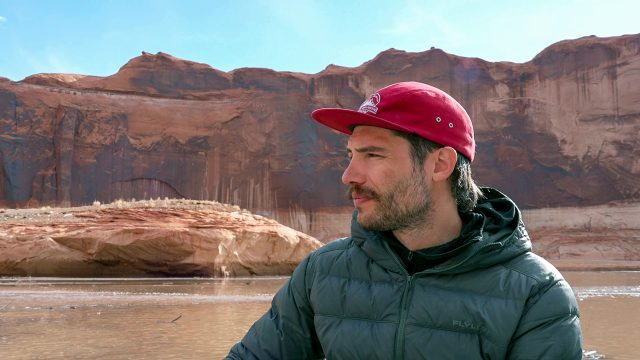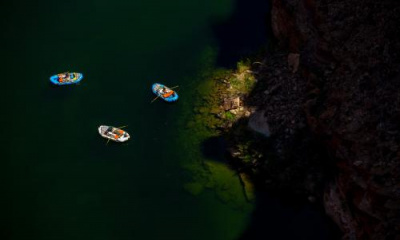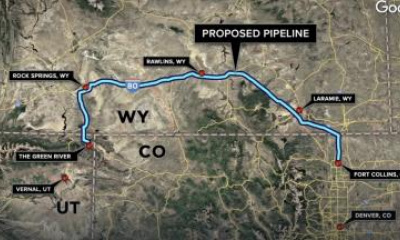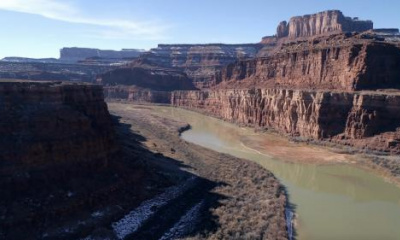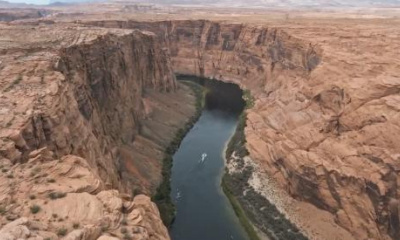ST. GEORGE — Sand waves flow behind Jack Stauss, repeatedly rolling and breaking near a debris-heavy section of the river as he discusses sediment-related phenomena in Lake Powell.
“That’s the delta making itself — basically recycling itself,” Stauss, the outreach director at Glen Canyon Institute, told St. George News.
He and Davide Ippolito, a boat operator and river guide with the Returning Rapids Project, were guiding a small boat through debris near the Escalante River delta — where the river meets Lake Powell and deposits sediment.
“That’s where the river dies,” Ippolito said.
Sand waves are one of many sediment-related phenomena at Lake Powell. They form in water containing a high percentage of sediment when the river’s bottom isn’t perfectly flat. Sediment builds up and forms a mound, slowing the water down and forming another mound, Ippolito said.
“They just keep growing until they hit a cataclysmic point where they all just crash,” he said.
Created on the Utah-Arizona border with the 1963 construction of the Glen Canyon Dam, Lake Powell, the nation’s second-largest reservoir, could once hold almost 26 million acre-feet of water. But, according to a 2022 report from the U.S. Geological Survey, its capacity has since dropped by nearly 7%, primarily due to sediment deposited by the Colorado River’s tributaries and trapped by Lake Powell’s still waters.
The reservoir’s storage capacity was calculated three times: in 1963 before the dam was built, in 1986 and from 2017 to 2018. In an email to St. George News, U.S. Bureau of Reclamation officials reported that the primary cause of storage loss is implied to be delta deposits from the Colorado and San Juan rivers.
Stauss said these two rivers move a “massive amount of sediment,” with the San Juan delivering nearly 75% of the load.
“And, as the water level changes, the deltas move — threatening resources in Glen Canyon,” he added.
When asked if sediment buildup at Lake Powell is an issue, Bureau of Reclamation officials said, “No.”
“All reservoirs accumulate sediment over their lifetime,” bureau staff wrote in an email. “If you compare the loss of capacity from 1963-1986 (-6.79% or -0.00123%/year) and the loss of capacity from 1986-2018 (-4.00% or -0.00125%/year) the loss of capacity is nearly constant and confirms the findings of the last major study completed in 1986.”
According to the Glen Canyon Institute, which advocates for “the restoration of Glen Canyon and a free flowing Colorado River,” 100 million tons of sediment are deposited in the reservoir yearly — “the equivalent of 30,000 dump truck loads each day.”
The nonprofit states that if the dam were removed, the sediment in the main channel could be flushed out in about five years, but if nothing changes, the reservoir will continue losing storage capacity.
“Ultimately, all dams fill with sediment or are destroyed by floods,” the institute states.
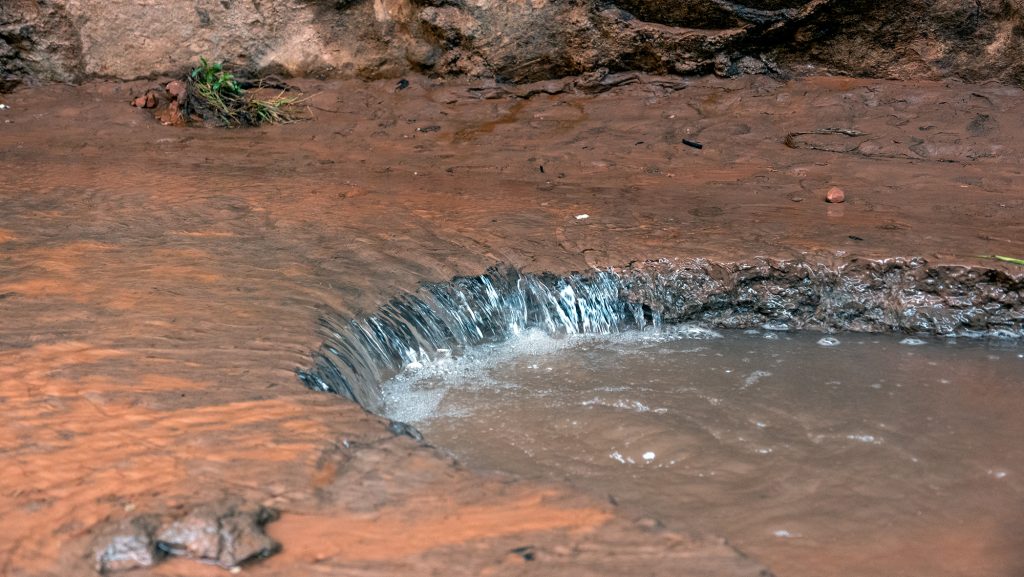
Water cuts through sediment in a side canyon at Lake Powell, Utah, March 25, 2024 | Photo by Alysha Lundgren, St. George News
A geological survey study published in 2022 estimated that while Lake Powell could be filled with sediment within approximately 750 years, “it would likely cease to be useful sooner.” This is due to the reservoir filling with sediment laterally as deltas move toward the dam, with losses reportedly greater at higher elevations.
As the landscape changes, some of the system’s rivers are forming “giant mud glaciers,” Returning Rapids principal investigator Mike Dehoff wrote in his 2022 article, “Who is in Charge of the Mud?” River deltas are accumulating sediment that is over 100 feet deep in some areas of Lake Powell’s canyons and moving downstream. The San Juan River delta was moving at a reported pace of 130 feet daily.
The Returning Rapids Project is run under the Glen Canyon Institute, in which a “group of river loving folks based in Moab” document “the recovery of the Colorado River in Cataract Canyon, upper Glen Canyon, and along the San Juan,” according to its website.
Different areas of the canyon hold different amounts of sediment with various qualities, Stauss said.
“Downstream, there is less at river level, as the sediment hasn’t traveled as far. But, at the tributary mouths, you again will find sediment,” he said. “We have done some preliminary survey work to document the amount of sediment in different places in the canyon.”
In Cataract Canyon near the town of Hite, 50-foot walls — layers of clay, silt, gravel and organic material — of Dominy Formation sediment can be seen. The Dominy Formation was named for the Bureau of Reclamation’s Floyd Dominy, who was the commissioner when Glen Canyon Dam was constructed.
While sediment naturally occurs in all rivers, the deltas can become problematic, Stauss said.
“When it’s locked up by a reservoir, it creates these delta formations that essentially clog the river,” he said. “So, as the deltas move with the seasonal runoff and monsoon cycles, it creates these plugs in these canyons that we can find. And in the side canyons, it’s a lot sandier, so it flushes out quicker with flash floods. But in the main stems, it’s much more like thick, almost mudlike, and it gets stuck. So, it creates these big, sometimes 150-foot walls.”
Every season on the reservoir and nearby rivers is different, Stauss said, adding the amount of sediment moved downstream depends on runoff and other geological factors.
For instance, the Returning Rapids Project reports in its 2023 field report that a “drowned rapid” in Gypsum Canyon returned as the reservoir receded and the river began to move out deposited sediment and “slowly, more gradient and obstacles have appeared.”
“Runoff this year has been just below average,” Stauss said. “But new research is being done on how much sediment is moving through the canyons overtime, and where it is going and at what rate. A finding, for example, from 2023, (shows) that there was as much as 10 meters of sediment downcut from the river corridor in 2023 during runoff.”
Additionally, Stauss said each tributary is different, and some deltas will erode over time while others become part of the landscape.
“These canyons, these mountains, this red rock around us is eroding,” he said. “It’s all kind of crumbling down into the rivers. The wind and the water is moving all this earth down and it wants to get to the ocean eventually, but it gets stuck here. The wall gets stuck, it piles up, and once it’s dry, it actually doesn’t make for terrible habitat for things to grow.”
However, while Glen Canyon’s ecosystems have begun to regrow in these areas, Ippolito said one issue facing the native flora and fauna is that there’s too much sediment all at once.
“It’s too much of a good thing,” he said.
Comparatively, Stauss said he’s received reports that the Grand Canyon is starved of sediment, with only 5% of the historic sediment amount making it downstream.
“The Grand Canyon is like 280 miles of desert canyon that also needs sediment to rebuild beaches and help restore ecosystems,” he said.
Sediment replenishes nutrients in the Colorado River and provides temporary habitat necessary for native fishes. To restore sandbars and beaches in the Grand Canyon, the Bureau of Reclamation began experimental high-flow releases through the dam in 2018, according to a news release issued by the agency.
Stauss said he thinks the Grand and Glen canyons should be allowed to have more natural sediment movement. However, more research must be conducted to determine the best way to move the sediment through the Glen Canyon Dam and the Hoover Dam at Lake Mead in Nevada.
The Glen Canyon Institute advocates for filling Lake Mead First — using Lake Powell as a backup — to allow the restoration of Glen Canyon’s ecosystems. Eventually, the nonprofit believes bypass tunnels should be constructed around Glen Canyon Dam so the Colorado River can flow freely around it.
This plan of action would reinstitute “normalized sediment flows” to the Grand Canyon, the institute adds.
Sediment concerns are coupled with the reservoir’s dropping and fluctuating water levels due to climate change and a drought that’s lasted over two decades.
This has caused some to raise the alarm, as, according to the geological survey, the dam provides about 40 million people with water, irrigates 5.5 million acres of agricultural land and can generate over 4,200 megawatts of hydroelectric power.
Added Stauss: “I think there’s big strategies that they — they being the Bureau of Reclamation and the park service, the federal government — needs to study. … Because it’s not like, ‘Let’s just wait and see.’ We’re past that point. And I think that’s really the crux of what our work is at the Returning Rapids Project and the Glen Canyon Institute. It’s to push these agencies to allocate real resources to studying some of these complex problems.”

